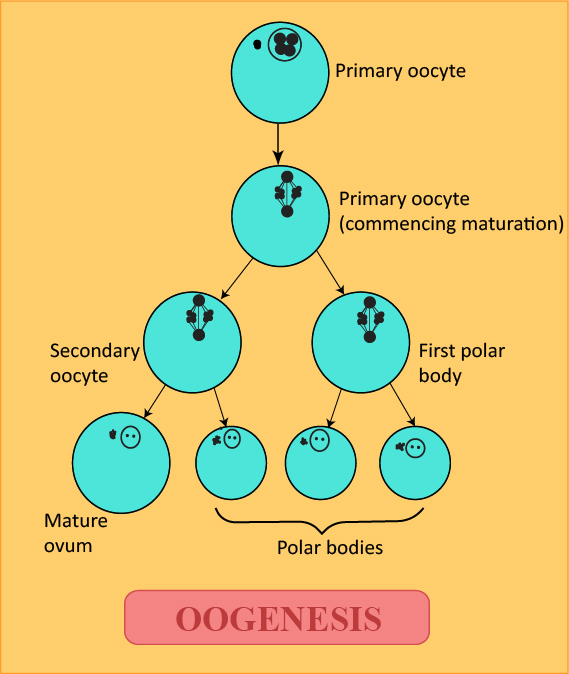
Explain the process of oogenesis in humans.
Answer
577.5k+ views
Hint: In the human female reproductive system, a growth process takes place which is responsible for the development of the primary egg cell (or ovum) into a mature and functional ovum.
Complete answer:
In the case of a woman, the egg’s development starts before the female that carries it is even born; 8 to 20 weeks after the fetus has started to grow, the cells that are to become mature ova start multiplying. By the time the female is born, all of the egg cells that the ovaries will release during the active reproductive years of the female are already present in the ovaries. These cells are known as the primary ova and are around 400,000 in number. The primary ova remains dormant until the ovulation when an egg is released from the ovary.
The egg then undergoes cell division. The nucleus splits such that half of its chromosomes go to one cell and a half to another. One of these two new cells is usually larger than the other and is known as the secondary ovum and the smaller cell is known as a polar body. The secondary ovum grows in the ovary until it reaches the maturation; it then breaks loose and is carried into the fallopian tubes. Once in the fallopian tubes, the secondary egg cell is now suitable for fertilization by the male sperm cells.
Some egg cells may not even mature for 40 years; others degenerate and never mature.

Note: Most women release an egg cell every menstrual cycle (vaginal bleeding that occurs as part of a woman's monthly cycle), this is called ovulation. After 12-24 hours, the egg cell dies and it won’t be possible to become pregnant again until the next cycle.
Complete answer:
In the case of a woman, the egg’s development starts before the female that carries it is even born; 8 to 20 weeks after the fetus has started to grow, the cells that are to become mature ova start multiplying. By the time the female is born, all of the egg cells that the ovaries will release during the active reproductive years of the female are already present in the ovaries. These cells are known as the primary ova and are around 400,000 in number. The primary ova remains dormant until the ovulation when an egg is released from the ovary.
The egg then undergoes cell division. The nucleus splits such that half of its chromosomes go to one cell and a half to another. One of these two new cells is usually larger than the other and is known as the secondary ovum and the smaller cell is known as a polar body. The secondary ovum grows in the ovary until it reaches the maturation; it then breaks loose and is carried into the fallopian tubes. Once in the fallopian tubes, the secondary egg cell is now suitable for fertilization by the male sperm cells.
Some egg cells may not even mature for 40 years; others degenerate and never mature.

Note: Most women release an egg cell every menstrual cycle (vaginal bleeding that occurs as part of a woman's monthly cycle), this is called ovulation. After 12-24 hours, the egg cell dies and it won’t be possible to become pregnant again until the next cycle.
Recently Updated Pages
Why are manures considered better than fertilizers class 11 biology CBSE

Find the coordinates of the midpoint of the line segment class 11 maths CBSE

Distinguish between static friction limiting friction class 11 physics CBSE

The Chairman of the constituent Assembly was A Jawaharlal class 11 social science CBSE

The first National Commission on Labour NCL submitted class 11 social science CBSE

Number of all subshell of n + l 7 is A 4 B 5 C 6 D class 11 chemistry CBSE

Trending doubts
What is meant by exothermic and endothermic reactions class 11 chemistry CBSE

10 examples of friction in our daily life

One Metric ton is equal to kg A 10000 B 1000 C 100 class 11 physics CBSE

1 Quintal is equal to a 110 kg b 10 kg c 100kg d 1000 class 11 physics CBSE

Difference Between Prokaryotic Cells and Eukaryotic Cells

What are Quantum numbers Explain the quantum number class 11 chemistry CBSE




